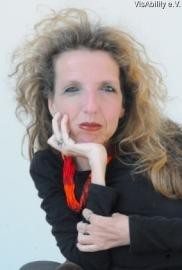Gerda König (disabled) was born in Cologne in 1966 and studied psychology at the University of Cologne (Germany). She began to focus on the medium of dance in 1991. After collaborating with the Mobiaki dance ensemble and the Paradox Dance Company, she established the DIN A 13 Dance Company in 1995, one of the few mixed-abled dance companies worldwide. Her visual language breaks down the presumed boundaries and values between physical characteristics and top dance performance.
Since then she has worked as the ensemble’s artistic director and as one of its dancers, and has staged numerous feature-length productions that have been performed at international dance festivals in Europe and North and South America. Over the last time, she has constantly built on her experiences in working artistically with dancers with and without disabilities in form of diverse dance commissions in countries such as the US, South Africa and Ethiopia.
In 2005, she instigated the project ‘Dance meets differences’ with the aim of using the medium of dance to foster intercultural exchanges and to establish new mixed-abled companies in various continents. The project was supported by the German Federal Cultural Foundationin cooperation with the Goethe-Institute Sao Paulo (Brazil) and Nairobi (Kenya). Since that time she has developed further productions in Cape Town (South Africa), Accra (Ghana), Dakar (Senegal), Colombo (Sri Lanka), Caracas (Venezuela) and Israel.
Regarding her work, Gerda König says: “In my work with dancers who do not conform to the usual social and aesthetic norms, I am impressed time and time again by the beauty and perfection of their unique movements. The unexpectedness of ‘another body’ becomes an aesthetic experience, whose expression sets new standards of quality and contrasts starkly with the classic concept of beautiful dance movement. It is particularly this kind of movement that constantly inspires and fascinates me in my choreographic work, and which not only challenge habitual ways of seeing and standard ideals of contemporary dance but also enrich it by giving it new impetus. My artistic work often focuses on the way humans are torn between their own emotions and desires and between inner and social conflicts. In my choreographic images I seek contrasts and provocations that ask questions and incite debate. Here, the dance material is developed in close collaboration with the dancers and demands the transformation of personal experience, feelings or memories into movement. For me it is important that the dance expression is charged with emotion so that the dance is brought alive for the audience.”
